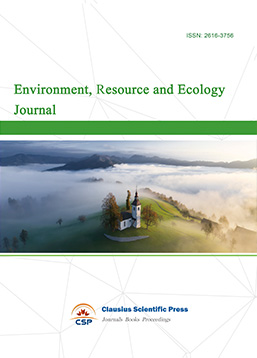Research on Shallow Groundwater Enrichment Assessment Based on RS and GIS Arid and Semi-Arid Areas
DOI: 10.23977/geors.2022.050106 | Downloads: 20 | Views: 2883
Author(s)
Chuanyue Yang 1
Affiliation(s)
1 Defense Engineering College, Army Engineering University, Nanjing, Jiangsu, 210007, China
Corresponding Author
Chuanyue YangABSTRACT
The area of arid and semi-arid areas in the world is increasing; in order to solve the issues related to the shallow groundwater enrichment assessment of the arid semi-arid areas, take the typical arid and semi-arid area as the research area of Wuwei Citizen Qin County, Gansu, through remote sensing, GF-6, CBERS04 and DEM are used as data sources to use layer analysis to build an evaluation model for hierarchical enrichment results. It has obtained the laws of shallow groundwater distribution in the research zone in the past five years and the next five years. The trend of water level distribution in the past five years is generally consistent, showing from the southwest to the northeast gradually decreases, there are multiple groundwater funnels, and the shallow groundwater content will remain stable and will increase slightly in the next five years. The results of this study evaluate the development trend of shallow groundwater in Wuwei citizens in Gansu; it provides a scientific basis for future shallow groundwater management.
KEYWORDS
RS, GIS, Shallow Groundwater, Enrichment Assessment, GF-6, AHPCITE THIS PAPER
Chuanyue Yang, Research on Shallow Groundwater Enrichment Assessment Based on RS and GIS Arid and Semi-Arid Areas. Geoscience and Remote Sensing (2022) Vol. 5: 40-47. DOI: http://dx.doi.org/10.23977/geors.2022.050106.
REFERENCES
[1] Liamas M R, Martinez-Santos P Intensive groundwater use Silent revolution and a potential source of social conflicts [J]. J Water Resour Plan Manage,2005,131(5):337-341.
[2] EDT AE., OKEREKECS, TEMESC, et al.Application of remote-sensing data to groundwater exploration: A case study of the Cross River State, southeastern Nigeria [J].Hydrogeology Journal, 1998,6(3):394-404.
[3] SENER E, DAVRAZ A, OZCELIK M.An integration of GIS and remote sensing in groundwater in-investigations: A case study in Burdur, Turkey [J].Hydrogeology Journal,2005,13(5-6):826-834.
[4] HADEELA S,MUSHTAKTJ,CHENXL.Application of Remote Sensing and GIS to the Study of Land Use/Cove Change and Urbanization Expansion in Basrah Province, Southern Iraq [J].Geo-Spatial Information Science,2009,12(2):135- 141.
[5] OLUTOYIN A F, MOSHOOD NT, ABELO T, et al.Delineation of potential groundwater zones in The crystalline basement terrain of SW-Nigeria: an integrated GIS and remote sensing approach [J]. Berlin Heidelberg: Springer, 2014, 4(1): 19-38.
[6] OIKONOMIDIS D, DIMOGIANNIS, KAZAKIS N, et al.A GIS/Remote Sensing-based methodology for groundwater potentiality assessment in Tirnavos area, Greece[J].Journal of Hydrology,2015,525:197-208.
[7] BAGYARAJ M, RAMKUMAR T, VENKATRAMANAN S,et al. Application of remote sensing and GIS analysis for identifying potential groundwater zone in parts of Kodaikanal Taluk, South India [J]. Frontiers of Earth Science,2013,7(1):65-75.
[8] Finizio A, Villa S. Environmental Risk Assessment for Pesticides: A tool for Decision Making[J]. Environmental Impact Assessment Review, 2002, 22(3): 235-248.
[9] Jha M K, Chowdary V M, Chowdhury A. Groundwater Assessment in Salboni Block, West Bengal (India) Using Remote Sensing, Geographical Information System and Multi-criteria Decision Analysis Technique[J]. Hydrogeology Journal, 2010, 18(7): 1713-1728.
| Downloads: | 1086 |
|---|---|
| Visits: | 114263 |
Sponsors, Associates, and Links
-
International Journal of Geological Resources and Geological Engineering

-
Big Geospatial Data and Data Science

-
Solid Earth and Space Physics

-
Environment and Climate Protection

-
Journal of Cartography and Geographic Information Systems

-
Environment, Resource and Ecology Journal

-
Offshore and Polar Engineering

-
Physical and Human Geography

-
Journal of Atmospheric Physics and Atmospheric Environment

-
Trends in Meteorology

-
Journal of Coastal Engineering Research

-
Focus on Plant Protection

-
Toxicology and Health of Environment

-
Advances in Physical Oceanography

-
Biology, Chemistry, and Geology in Marine

-
Water-Soil, Biological Environment and Energy

-
Geodesy and Geophysics

-
Journal of Structural and Quaternary Geology

-
Journal of Sedimentary Geology

-
International Journal of Polar Social Research and Review


 Download as PDF
Download as PDF